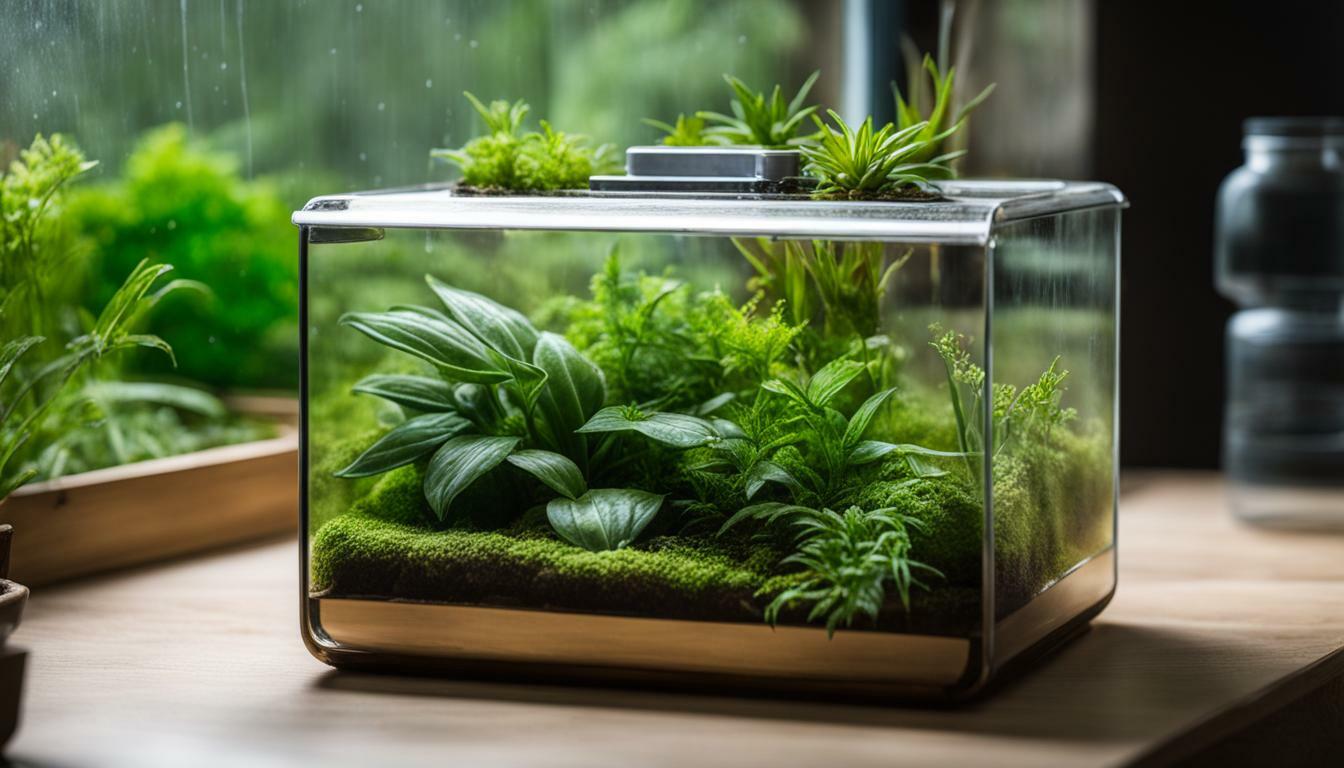Terrariums are closed self-sustaining environments that require basic care and attention. Proper humidity control is essential for the long and healthy life of a terrarium. Here are some key points to keep in mind:
Importance of Humidity in Terrarium Care
The right humidity is crucial for terrarium plants to thrive. The ideal humidity levels ensure proper plant growth, prevent diseases, and maintain a balanced ecosystem. It is essential for replicating the natural habitat of the plants within the terrarium.
Monitoring and Controlling Terrarium Humidity Levels
Regularly monitoring and controlling humidity levels is necessary to maintain optimal conditions. Using a hygrometer to measure humidity and implementing appropriate adjustments, such as adding or removing moisture, can help create a stable and healthy environment for your terrarium.
Increasing Humidity in a Terrarium
There are several methods to increase humidity in a terrarium. Mist spraying, using a humidity tray, or incorporating a humidifier are effective ways to raise moisture levels. These methods ensure that your plants receive the needed humidity for their growth and overall well-being.
Common Issues and Solutions
When dealing with terrarium humidity, there are common challenges that may arise. Taking steps to prevent and address issues like mould growth, mushrooms, and fungus gnats is important to maintain a healthy terrarium environment. Proper plant placement and good air circulation can also help overcome these challenges.
Proper Plant Selection for Terrariums
Choosing the right plants for your terrarium is crucial for humidity control. Opt for plants that thrive in high humidity environments and have similar moisture requirements. Ferns, air plants, peperomia, and orchids are excellent choices that add beauty and greenery to your terrarium ecosystem.
Key Takeaways:
- Proper humidity control is essential for the health and vitality of a terrarium.
- The right humidity levels promote plant growth and maintain a balanced ecosystem.
- Regularly monitor and adjust humidity levels using a hygrometer.
- Increasing humidity can be achieved through misting, humidity trays, or humidifiers.
- Common issues like mould, mushrooms, and fungus gnats can be prevented or addressed with proper care and maintenance.
- Choose plants that thrive in high humidity environments for your terrarium.
By following these guidelines, you can master the care of your terrarium and create a thriving and beautiful ecosystem.
Importance of Humidity in Terrarium Care
Understanding the significance of humidity in terrarium care is crucial for creating a thriving miniature ecosystem. Proper humidity levels provide the necessary moisture for plant growth and help maintain the delicate balance within the terrarium.
Terrariums are closed self-sustaining environments that require basic care and attention. The enclosed nature of a terrarium limits the exchange of moisture with the surrounding environment, making humidity control essential. Plants within the terrarium rely on the moisture in the air to meet their hydration needs. Without adequate humidity, plants can wilt, wither, and ultimately die.
Maintaining the proper humidity level is not only important for the plants but also for the overall ecosystem within the terrarium. Humidity affects the growth and development of microorganisms, fungi, and other living organisms that contribute to the terrarium’s balance. A properly humid environment promotes a healthy and harmonious ecosystem, reducing the risk of pest infestations and disease.
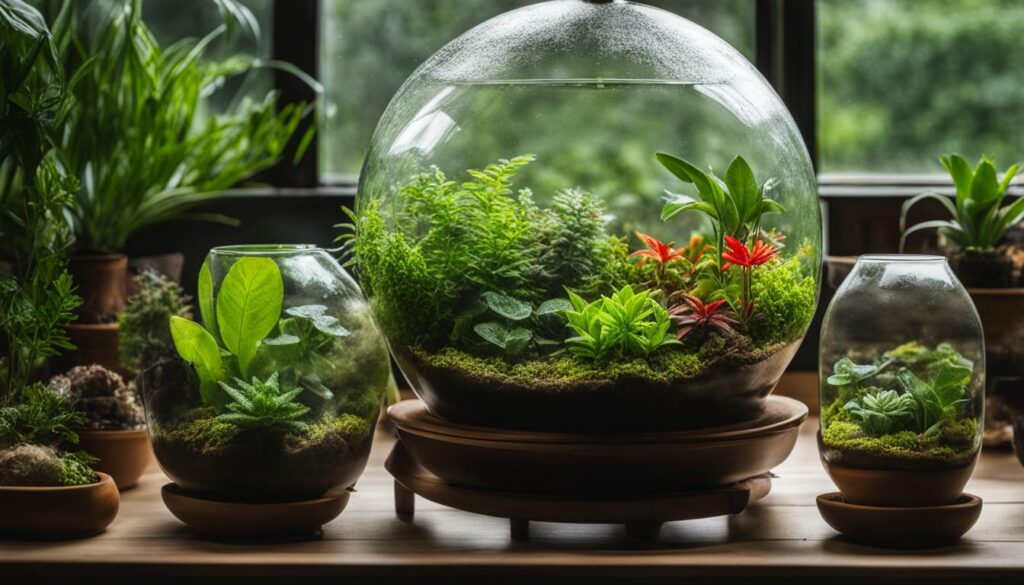
Monitoring and maintaining the humidity levels in your terrarium is crucial. To ensure optimal conditions, it’s important to consider factors such as lighting, temperature, and the presence of condensation. Terrariums should be placed in a well-lit area, but direct sunlight should be avoided as it can lead to excessive warmth and condensation. The average room temperature of 19-21°C is ideal for most terrarium plants.
Condensation is a normal occurrence in terrariums due to the moisture held in the living materials. However, excessive condensation can indicate an imbalance in humidity levels. If you notice too much condensation, it is advisable to remove the lid for a few hours to allow excess moisture to dissipate. This simple step can help maintain the ideal humidity level for your terrarium.
Summary
Proper humidity control is vital for the health and success of a terrarium. It ensures the necessary moisture for plant growth and supports a balanced ecosystem within the enclosed environment. By monitoring and adjusting humidity levels, you can create a thriving miniature world filled with lush greenery and captivating beauty.
Monitoring and Controlling Terrarium Humidity Levels
Maintaining the ideal humidity level in your terrarium requires careful monitoring and control. In this section, we will explore the best practices for monitoring humidity and making necessary adjustments to create a balanced and healthy environment for your terrarium plants.
The first step in monitoring terrarium humidity is to invest in a reliable hygrometer. This device measures the humidity levels inside your terrarium and helps you determine if adjustments are needed. Place the hygrometer in an area where it can accurately capture the overall humidity of the terrarium.
| Humidity Level | Actions Required |
|---|---|
| Below 50% | Add moisture to the terrarium. This can be done by misting the plants, adding a small dish of water, or using a humidifier. |
| Around 50-70% | Perfect range for most terrarium plants. Maintaining this level will promote healthy growth and prevent issues like mold or fungal growth. |
| Above 70% | Remove the terrarium lid for a few hours to allow excess moisture to evaporate. If the humidity remains high, increase air circulation by using a fan or opening a nearby window. |
Aside from monitoring humidity levels, another key aspect of terrarium care is adjusting humidity when necessary. Here are a few tips to help you maintain a balanced environment:
- Watering: If the terrarium is too dry, mist the plants and the surrounding materials to increase humidity. On the other hand, if condensation is excessive, reduce watering and allow the terrarium to dry out slightly.
- Air Circulation: Good air circulation is essential in preventing stagnant air and excessive moisture buildup. Open the terrarium lid regularly to promote fresh air exchange, especially when humidity levels are consistently high.
- Temperature Control: Temperature plays a crucial role in humidity regulation. Avoid placing your terrarium near heat sources or drafty areas, as they can disrupt the humidity balance. Maintain a consistent room temperature to prevent fluctuations in humidity levels.
Remember, maintaining proper humidity in your terrarium is a continuous process. Regularly monitor levels, make adjustments as needed, and observe how your plants respond. With proper care and attention to humidity control, you can create a thriving and beautiful terrarium ecosystem.
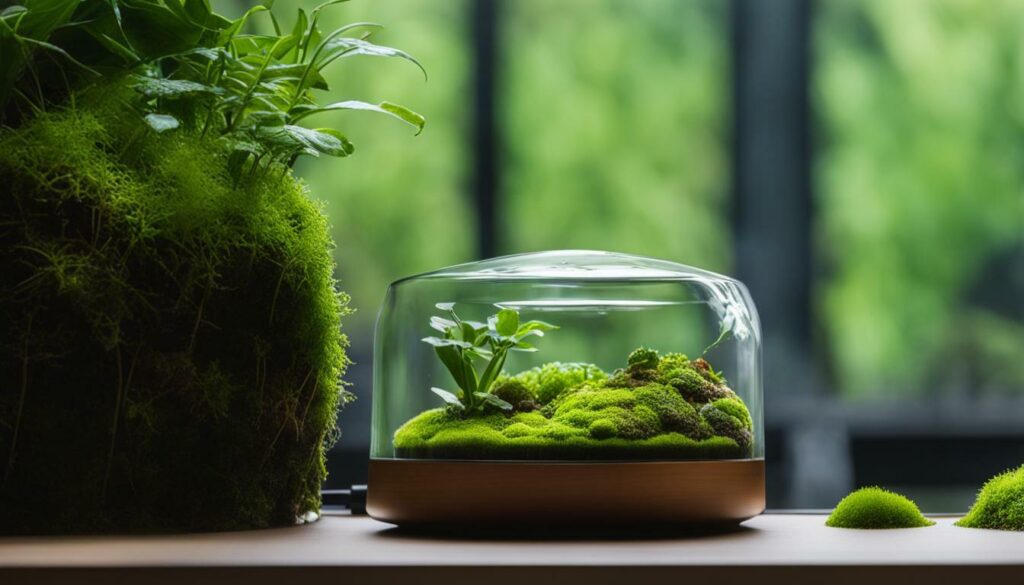
If your terrarium is experiencing low humidity levels, it’s essential to take action to increase moisture and create an optimal environment for your plants. In this section, we will explore effective methods for increasing humidity in a terrarium and introduce humidity control devices that can assist in maintaining the desired moisture levels.
One simple and cost-effective method for increasing humidity in a terrarium is misting. By using a spray bottle filled with filtered water, you can create a fine mist that will provide a temporary boost of moisture. Misting should be done regularly, but be cautious not to overdo it, as excessive moisture can lead to fungal growth and other issues.
Another method is using a humidity tray or pebble tray. This involves placing a shallow tray filled with water and decorative pebbles beneath the terrarium. As the water evaporates, it will increase the humidity levels inside the terrarium. It’s important to monitor the water level in the tray and refill it as needed to maintain consistent humidity.
Humidity Control Devices
If you’re looking for a more automated solution, humidity control devices can be a convenient option. One popular device is a humidifier, which releases a fine mist of water vapor into the air, increasing humidity levels in the terrarium. These devices often come with adjustable settings, allowing you to regulate the moisture output.
Another option is a hygrometer. A hygrometer is a device that measures the humidity levels in the terrarium. By monitoring the humidity levels, you can adjust the environment accordingly to maintain optimal conditions for your plants. Hygrometers are available in both analog and digital forms, and some even have built-in humidity control features.
Remember, proper humidity control is essential for the health and well-being of your terrarium plants. By following these methods and utilizing humidity control devices, you can create the ideal environment for your terrarium and ensure the success of your plant life.
| Method | Pros | Cons |
|---|---|---|
| Misting | – Simple and cost-effective – Provides temporary moisture boost | – Can lead to overwatering if done excessively – May result in fungal growth if not done properly |
| Humidity Tray | – Helps maintain consistent humidity levels – Easy to set up and maintain | – Requires regular monitoring and refilling of water – Can take up additional space |
| Humidifier | – Provides automated and adjustable humidity control – Suitable for larger terrariums | – May be costly to purchase and operate – Requires regular maintenance and cleaning |
| Hygrometer | – Allows accurate monitoring of humidity levels – Some models have built-in humidity control features | – Additional cost to purchase – Requires regular calibration and replacement of batteries if applicable |
Common Issues and Solutions
While maintaining humidity in a terrarium is generally straightforward, occasional issues may arise. In this section, we will discuss common problems associated with terrarium humidity control and provide effective tips and solutions to ensure the continued health and well-being of your terrarium ecosystem.
Mould or Fungus: If mould growth is noticed on leaves, remove it immediately and open the lid for a few hours to allow air circulation. Mould is caused by spores and overhumidity, so reducing moisture, maintaining good air circulation, and adding springtails can help prevent mould growth.
Mushrooms: Mushrooms can grow in terrariums and are a sign of a healthy environment. They will naturally die off in a few weeks, but if desired, they can be removed using gloves and tweezers.
Fungus Gnats: These small flies can be annoying but will not harm the plants. To reduce their population, remove excess soil from plant roots and let the terrarium dry out.
Tall Plants: If the plants are growing too tall, prune the stems or replace larger plants with smaller ones.
Weepy and Dry Plants: If the plants appear dry and pale, they may need moisture. Test the soil with your finger and water the base of the plants with filtered water if it is dry.
Regular maintenance includes cleaning out dead leaves, tidying up, removing dead plants, cleaning glass, and addressing any issues promptly.
Summary:
| Common Issues | Solutions |
|---|---|
| Mould or Fungus | Remove mould, increase air circulation, add springtails |
| Mushrooms | Naturally die off or remove if desired |
| Fungus Gnats | Remove excess soil and let terrarium dry out |
| Tall Plants | Prune stems or replace with smaller plants |
| Weepy and Dry Plants | Water base of plants if soil is dry |
When selecting plants for a terrarium, choose those that are small, slow-growing, and humidity-loving. Ferns, air plants, peperomia, and orchids are some suitable options.
Proper care includes providing bright, indirect sunlight, maintaining a consistent temperature, watering when necessary, and regular trimming. Fogging inside the terrarium is normal but can be reduced by adjusting humidity levels and allowing air circulation.
By following these guidelines, you can master the care of your terrarium and create a thriving and beautiful ecosystem.
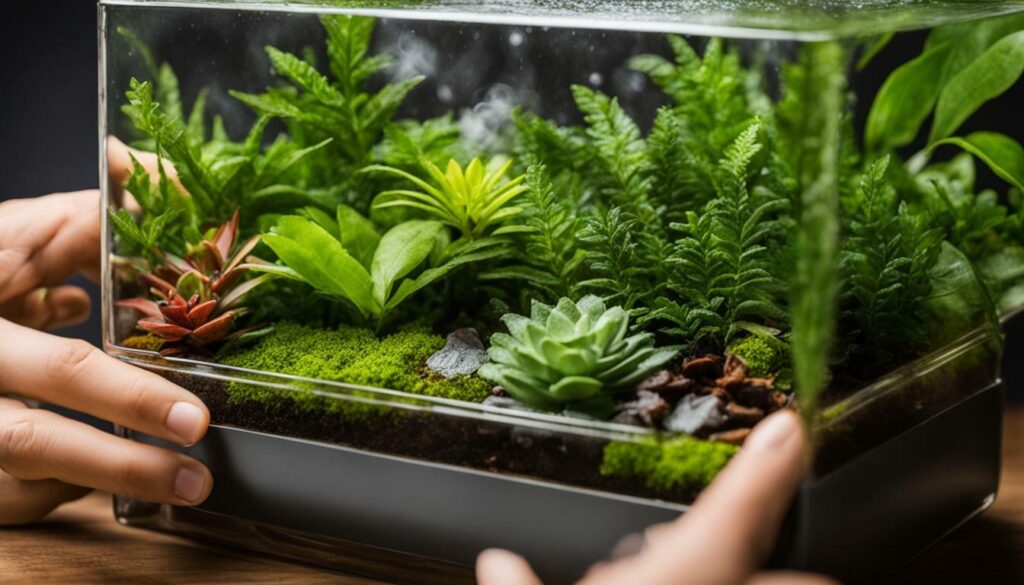
Choosing the appropriate plants for your terrarium is crucial for maintaining proper humidity levels and ensuring the long-term success of your miniature ecosystem. In this section, we will explore the best plant options that thrive in humid environments and provide insights on creating a visually pleasing terrarium.
When selecting plants for your terrarium, consider their growth habits, moisture requirements, and compatibility with the humid conditions inside. Here are some excellent plant choices:
| Plant | Lighting Requirements | Moisture Preferences | Height |
|---|---|---|---|
| Ferns | Indirect sunlight | Moist soil | Various heights |
| Air Plants | Bright, indirect sunlight | Mist or soak regularly | Compact, low-growing |
| Peperomia | Bright, indirect sunlight | Well-draining soil, moderate moisture | Compact, low-growing |
| Orchids | Bright, indirect sunlight | High humidity, occasional watering | Various heights |
These plants are well-suited for terrariums due to their ability to thrive in high humidity environments. They will complement each other and create an aesthetically pleasing arrangement within your terrarium.
When arranging the plants, consider their height and growth habits. Place taller plants towards the back or center of the terrarium, while shorter ones can be positioned towards the front. This layering technique adds depth and visual interest to your terrarium.
“The proper selection and arrangement of plants for your terrarium will not only ensure optimal humidity levels but also create a beautiful and balanced ecosystem.”
Remember to provide adequate lighting, maintain a consistent temperature, and monitor humidity levels to create an ideal environment for your terrarium plants. With careful plant selection and thoughtful design, you can enjoy the beauty of a thriving terrarium for years to come.
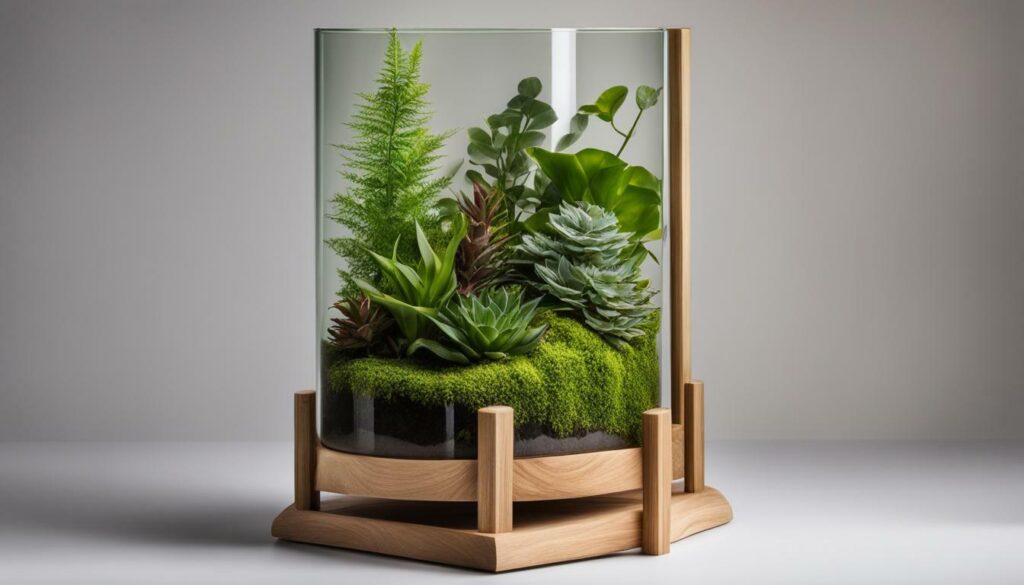
| Plant | Lighting Requirements | Moisture Preferences | Height |
|---|---|---|---|
| Ferns | Indirect sunlight | Moist soil | Various heights |
| Air Plants | Bright, indirect sunlight | Mist or soak regularly | Compact, low-growing |
| Peperomia | Bright, indirect sunlight | Well-draining soil, moderate moisture | Compact, low-growing |
| Orchids | Bright, indirect sunlight | High humidity, occasional watering | Various heights |
Care and Maintenance Tips for Terrariums
Caring for your terrarium involves several key aspects beyond humidity control. In this section, we will provide comprehensive care and maintenance tips to ensure your terrarium thrives. From lighting and temperature control to proper watering techniques, maintaining a healthy terrarium ecosystem is within reach.
Lighting & Temperature: Terrariums should be placed in a well-lit, but not directly sunlit, area. Direct sunlight can cause the terrarium to become too warm and result in excessive condensation. The average room temperature of 19-21°C is ideal.
Condensation: Condensation is a normal occurrence in terrariums due to the moisture held in the living materials. If there is too much condensation, it indicates an excess of moisture inside the terrarium. Removing the lid for half a day can help reduce excess moisture and maintain the ideal humidity level.
| Common Issues and Solutions |
|---|
| Mould or Fungus: If mould growth is noticed on leaves, remove it immediately and open the lid for a few hours to allow air circulation. Mould is caused by spores and overhumidity, so reducing moisture, maintaining good air circulation, and adding springtails can help prevent mould growth. |
| Mushrooms: Mushrooms can grow in terrariums and are a sign of a healthy environment. They will naturally die off in a few weeks, but if desired, they can be removed using gloves and tweezers. |
| Fungus Gnats: These small flies can be annoying but will not harm the plants. To reduce their population, remove excess soil from plant roots and let the terrarium dry out. |
| Tall Plants: If the plants are growing too tall, prune the stems or replace larger plants with smaller ones. |
| Weepy and Dry Plants: If the plants appear dry and pale, they may need moisture. Test the soil with your finger and water the base of the plants with filtered water if it is dry. |
Regular maintenance includes cleaning out dead leaves, tidying up, removing dead plants, cleaning glass, and addressing any issues promptly.
When selecting plants for a terrarium, choose those that are small, slow-growing, and humidity-loving. Ferns, air plants, peperomia, and orchids are some suitable options.
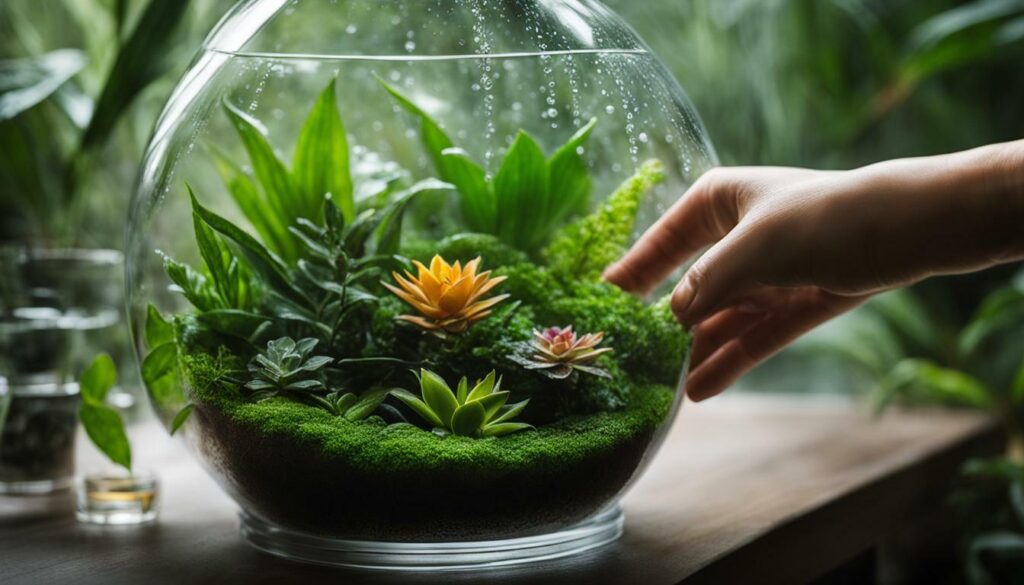
Proper care includes providing bright, indirect sunlight, maintaining a consistent temperature, watering when necessary, and regular trimming. Fogging inside the terrarium is normal but can be reduced by adjusting humidity levels and allowing air circulation.
By following these guidelines, you can master the care of your terrarium and create a thriving and beautiful ecosystem.
Troubleshooting and Common Challenges
Despite your best efforts, challenges may arise when caring for a terrarium. In this section, we will discuss common issues that terrarium enthusiasts face and provide troubleshooting tips and solutions to help you overcome them.
Mould or Fungus
If mould growth is noticed on leaves, remove it immediately and open the lid for a few hours to allow air circulation. Mould is caused by spores and overhumidity, so reducing moisture, maintaining good air circulation, and adding springtails can help prevent mould growth.
Mushrooms
Mushrooms can grow in terrariums and are a sign of a healthy environment. They will naturally die off in a few weeks, but if desired, they can be removed using gloves and tweezers.
Fungus Gnats
These small flies can be annoying but will not harm the plants. To reduce their population, remove excess soil from plant roots and let the terrarium dry out.
Tall Plants
If the plants are growing too tall, prune the stems or replace larger plants with smaller ones.
Weepy and Dry Plants
If the plants appear dry and pale, they may need moisture. Test the soil with your finger and water the base of the plants with filtered water if it is dry.
Regular maintenance includes cleaning out dead leaves, tidying up, removing dead plants, cleaning glass, and addressing any issues promptly.
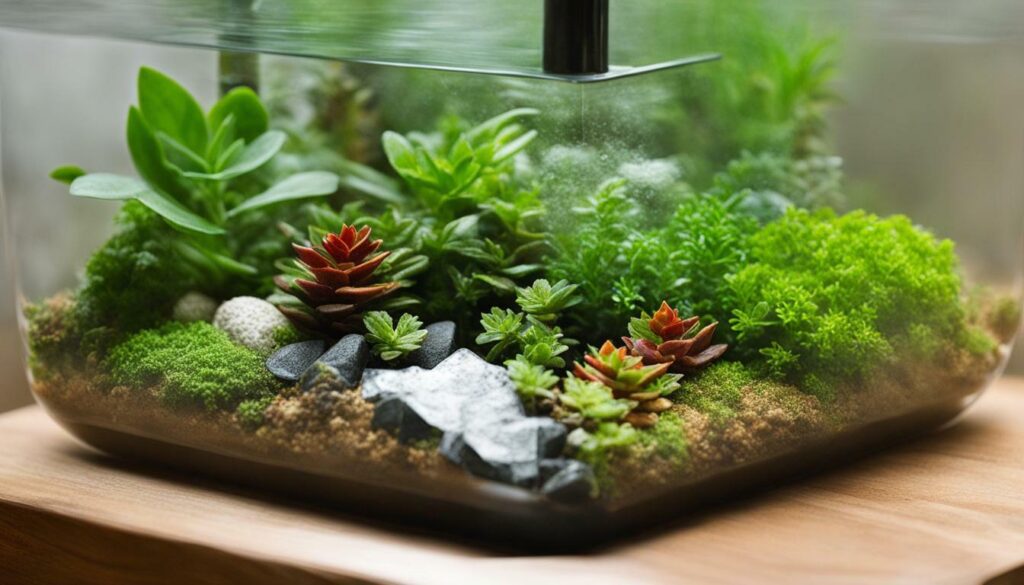
When selecting plants for a terrarium, choose those that are small, slow-growing, and humidity-loving. Ferns, air plants, peperomia, and orchids are some suitable options.
Proper care includes providing bright, indirect sunlight, maintaining a consistent temperature, watering when necessary, and regular trimming. Fogging inside the terrarium is normal but can be reduced by adjusting humidity levels and allowing air circulation.
By following these guidelines, you can master the care of your terrarium and create a thriving and beautiful ecosystem.
What Role Does Humidity Control Play in Seasonal Terrarium Care?
Humidity control is crucial in seasonal terrarium care adjustments. Proper humidity levels help maintain the health of the plants and animals inside the terrarium. During different seasons, the humidity within the terrarium may fluctuate, requiring adjustments to ensure that the environment remains suitable for its inhabitants.
Congratulations! You have now acquired the knowledge and skills to successfully control humidity in your terrarium and maintain a thriving miniature ecosystem.
By following the tips and techniques outlined in this guide, you can enjoy the beauty and tranquility of your terrarium for years to come. Terrariums are closed self-sustaining environments that require basic care and attention, with proper humidity control being essential for their long and healthy life.
When setting up your terrarium, it’s important to consider factors such as lighting and temperature. Place your terrarium in a well-lit area, but avoid direct sunlight as it can cause excessive condensation. The ideal room temperature for a terrarium is around 19-21°C.
Condensation is a normal occurrence in terrariums, but if there is excessive condensation, it indicates an excess of moisture inside. To reduce excess moisture, you can remove the lid for half a day, allowing for better air circulation and maintaining the ideal humidity level.
Watering your terrarium is different from traditional houseplants in pots. Instead of a set watering routine, observe the plants over time and water when needed. Wilting leaves and pale green moss are signs that your terrarium needs watering. Use filtered water and spray approximately 1-2 egg cups full, depending on the size of your terrarium. Avoid overwatering.
Common Issues and Solutions:
Mould or Fungus: If you notice mould growth on leaves, remove it immediately and open the lid for a few hours to allow air circulation. Mould is caused by spores and overhumidity, so reducing moisture, maintaining good air circulation, and adding springtails can help prevent mould growth.
Mushrooms: Mushrooms can naturally grow in terrariums and are a sign of a healthy environment. They will naturally die off in a few weeks, but if desired, they can be removed using gloves and tweezers.
Fungus Gnats: These small flies can be annoying but will not harm the plants. To reduce their population, remove excess soil from plant roots and let the terrarium dry out.
Tall Plants: If the plants in your terrarium are growing too tall, prune the stems or replace larger plants with smaller ones to maintain a balanced ecosystem.
Weepy and Dry Plants: If the plants in your terrarium appear dry and pale, they may need moisture. Test the soil with your finger and water the base of the plants with filtered water if it is dry.
Regular maintenance of your terrarium includes cleaning out dead leaves, tidying up, removing dead plants, cleaning the glass, and addressing any issues promptly. When selecting plants for your terrarium, choose ones that are small, slow-growing, and humidity-loving, such as ferns, air plants, peperomia, and orchids.
Proper care of your terrarium involves providing bright, indirect sunlight, maintaining a consistent temperature, watering when necessary, and regular trimming. Fogging inside the terrarium is normal but can be reduced by adjusting humidity levels and allowing air circulation.
By following these guidelines, you can master the care of your terrarium and create a thriving and beautiful ecosystem. Congratulations on your new expertise and enjoy the wonders of your terrarium!
FAQ
What is the importance of humidity in terrarium care?
Humidity is important in terrarium care as it creates the optimal environment for plant growth and ecosystem balance. It ensures that plants receive the moisture they need and helps maintain overall health and vitality.
How do I monitor and control humidity levels in a terrarium?
To monitor humidity levels, use a hygrometer or observe condensation on the terrarium walls. To control humidity, regulate the amount of ventilation, adjust watering frequency, and use a mister or humidifier if necessary.
How can I increase humidity in a terrarium?
To increase humidity, mist the terrarium with water, place a tray of water near the terrarium, or use a small humidifier. You can also cover the terrarium with a glass lid or plastic wrap to retain moisture.
What are some common issues related to terrarium humidity and their solutions?
Common issues include mould growth, mushrooms, and fungus gnats. To address mould, remove it immediately and increase air circulation. Mushrooms are harmless and will die off naturally. To control fungus gnats, remove excess soil and allow the terrarium to dry out.
What plants are suitable for terrariums?
Suitable plants for terrariums include ferns, air plants, peperomia, and orchids. Choose small, slow-growing plants that thrive in humid environments.
What are some care and maintenance tips for terrariums?
Provide bright, indirect sunlight, maintain a consistent temperature, water when necessary, and regularly trim the plants. Also, clean out dead leaves, remove dead plants, and clean the glass as needed.
What are some common challenges in terrarium care?
Common challenges include overwatering, tall plant growth, and dry or weepy plants. Avoid overwatering by observing the plants’ needs. Prune tall plants or replace them with smaller ones. If plants appear dry, test the soil and water as needed.

